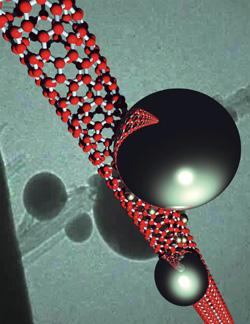
Frontiers in Nanoscience, page three

In a development that brings the promise of mass production to nanoscale devices, Berkeley Lab scientists have transformed carbon nanotubes into conveyor belts capable of ferrying atom-sized particles to microscopic worksites. Someday, a nano-scale conveyor belt such as the one shown in this simulation could expedite the atom-by-atom construction of the world's smallest devices. Image courtesy of Zettl Research Group.
Just as the Microtechnology Age was built upon the introduction of impurities into crystals of semiconductor materials, so too will crystalline doping be the bedrock upon which the Nanotechnology Age is built. Another Alivisatos-led team showed just what happens to nanosized crystals under the various forms of crystalline doping.
They demonstrated that for nanocrystals, the doping process in which one type of positively charged atom, or cation, is exchanged for another takes place at a much faster rate than for microsized crystals, and is fully rever-sible, something that is virtually forbidden in the larger crystals under the same environmental conditions. This should accelerate the process of developing doped nanocrystals.
Another breakthrough was achieved by a Berkeley Lab-UC Berkeley team led by chemist Peidong Yang, who grew nanowires out of the highly prized semiconductor gallium nitride, and controlled the direction in which these nanowires grew. Growth direction is critical to determining a nanowire’s electrical and thermal conductivity and other important properties. Nanotechnologists are eager to tap into the enormous potential of gallium nitride for use in high-power, high-performance optoelectronic devices. With further development, the technology of Yang and his colleagues should make it possible for gallium nitride nanowires to be integrated with thin films of various compositions to produce light-emitting diodes, transistors, biochemical sensors and ultraviolet-wavelength nanolasers.
Yet another development brings the promise of mass production to nanoscale devices. A team of Berkeley Lab and UC Berkeley researchers led by physicist Alex Zettl has been able to transform carbon nanotubes into conveyor belts capable of ferrying atom-sized particles to microscopic worksites. By applying a small electrical current to a carbon nanotube, the team was able to move individual atoms of indium along the tube, like auto parts on an assembly line. In a series of tests, the indium was repeatedly moved back and forth along the nanotube without losing a single atom. This research lays the groundwork for the high-throughput construction of the atomic-scale optical, electronic, and mechanical components from which future nanodevices will be fabricated.